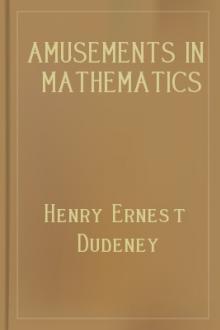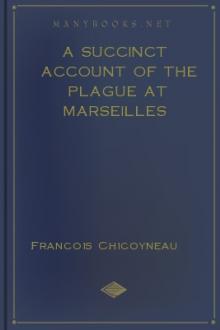Amusements in Mathematics, Henry Ernest Dudeney [books to read to be successful txt] 📗

- Author: Henry Ernest Dudeney
- Performer: 0486204731
Book online «Amusements in Mathematics, Henry Ernest Dudeney [books to read to be successful txt] 📗». Author Henry Ernest Dudeney
It will be noticed that I have struck out with little cross strokes five lines or edges in the diagram. These five lines may be struck out anywhere so long as they do not join one another, and so long as one of them does not connect with N, the North Pole, from which we are to start. It will be seen that the result of striking out these five lines is that all the nodes are now even except N and S. Consequently if we begin at N and stop at S we may go over all the lines, except the five crossed out, without traversing any line twice. There are many ways of doing this. Here is one route: N to H, I, K, S, I, E, S, G, K, D, H, A, N, B, A, E, F, B, C, G, D, N, C, F, S. By thus making five of the routes as short as is possible—simply from one node to the next—we are able to get the greatest possible length for our sixth line. A greater distance in one route, without going over the same ground twice, it is not possible to get.
It is now readily seen that those five erased lines must be gone over twice, and they may be "picked up," so to speak, at any points of our route. Thus, whenever the traveller happens to be at I he can run up to A and back before proceeding on his route, or he may wait until he is at A and then run down to I and back to A. And so with the other lines that have to be traced twice. It is, therefore, clear that he can go over 25 of the lines once only (25 × 10,000 miles = 250,000 miles) and 5 of the lines twice (5 × 20,000 miles = 100,000 miles), the total, 350,000 miles, being the length of his travels and the shortest distance that is possible in visiting the whole body.
It will be noticed that I have made him end his travels at S, the South Pole, but this is not imperative. I might have made him finish at any of the other nodes, except the one from which he started. Suppose it had been required to bring him home again to N at the end of his travels. Then instead of suppressing the line AI we might leave that open and close IS. This would enable him to complete his 350,000 miles tour at A, and another 10,000 miles would take him to his own fireside. There are a great many different routes, but as the lengths of the edges are all alike, one course is as good as another. To make the complete 350,000 miles tour from N to S absolutely clear to everybody, I will give it entire: N to H, I, A, I, K, H, K, S, I, E, S, G, F, G, K, D, C, D, H, A, N, B, E, B, A, E, F, B, C, G, D, N, C, F, S—that is, thirty-five lines of 10,000 miles each.
247.—INSPECTING A MINE.—solution
Starting from A, the inspector need only travel 36 furlongs if he takes the following route: A to B, G, H, C, D, I, H, M, N, I, J, O, N, S, R, M, L, G, F, K, L, Q, R, S, T, O, J, E, D, C, B, A, F, K, P, Q. He thus passes between A and B twice, between C and D twice, between F and K twice, between J and O twice, and between R and S twice—five repetitions. Therefore 31 passages plus 5 repeated equal 36 furlongs. The little pitfall in this puzzle lies in the fact that we start from an even node. Otherwise we need only travel 35 furlongs.
248.—THE CYCLIST'S TOUR.—solution
When Mr. Maggs replied, "No way, I'm sure," he was not saying that the thing was impossible, but was really giving the actual route by which the problem can be solved. Starting from the star, if you visit the towns in the order, NO WAY, I'M SURE, you will visit every town once, and only once, and end at E. So both men were correct. This was the little joke of the puzzle, which is not by any means difficult.
249.—THE SAILOR'S PUZZLE.—solution

There are only four different routes (or eight, if we count the reverse ways) by which the sailor can start at the island marked A, visit all the islands once, and once only, and return again to A. Here they are:—
A I P T L O E H R Q D C F U G N S K M B A A I P T S N G L O E U F C D K M B Q R H A A B M K S N G L T P I O E U F C D Q R H A A I P T L O E U G N S K M B Q D C F R H A
Now, if the sailor takes the first route he will make C his 12th island (counting A as 1); by the second route he will make C his 13th island; by the third route, his 16th island; and by the fourth route, his 17th island. If he goes the reverse way, C will be respectively his 10th, 9th, 6th, and 5th island. As these are the only possible routes, it is evident that if the sailor puts off his visit to C as long as possible, he must take the last route reading from left to right. This route I show by the dark lines in the diagram, and it is the correct answer to the puzzle.
The map may be greatly simplified by the "buttons and string" method, explained in the solution to No. 341, "The Four Frogs."
250.—THE GRAND TOUR.—solution
The first thing to do in trying to solve a puzzle like this is to attempt to simplify it. If you look at Fig. 1, you will see that it is a simplified version of the map. Imagine the circular towns to be buttons and the railways to be connecting strings. (See solution to No. 341.) Then, it will be seen, we have simply "straightened out" the previous diagram without affecting the conditions. Now we can further simplify by converting Fig. 1 into Fig. 2, which is a portion of a chessboard. Here the directions of the railways will resemble the moves of a rook in chess—that is, we may move in any direction parallel to the sides of the diagram, but not diagonally. Therefore the first town (or square) visited must be a black one; the second must be a white; the third must be a black; and so on. Every odd square visited will thus be black and every even one white. Now, we have 23 squares to visit (an odd number), so the last square visited must be black. But Z happens to be white, so the puzzle would seem to be impossible of solution.

As we were told that the man "succeeded" in carrying put his plan, we must try to find some loophole in the conditions. He was to "enter every town once and only once," and we find no prohibition against his entering once the town A after leaving it, especially as he has never left it since he was born, and would thus be "entering" it for the first time in his life. But he must return at once from the first town he visits, and then he will have only 22 towns to visit, and as 22 is an even number, there is no reason why he should not end on the white square Z. A possible route for him is indicated by the dotted line from A to Z. This route is repeated by the dark lines in Fig. 1, and the reader will now have no difficulty in applying; it to the original map. We have thus proved that the puzzle can only be solved by a return to A immediately after leaving it.
251.—WATER, GAS, AND ELECTRICITY.—solution

According to the conditions, in the strict sense in which one at first understands them, thereis no possible solution to this puzzle. In such a dilemma one always has to look for some verbal quibble or trick. If the owner of house A will allow the water company to run their pipe for house C through his property (and we are not bound to assume that he would object), then the difficulty is got over, as shown in our illustration. It will be seen that the dotted line from W to C passes through house A, but no pipe ever crosses another pipe.
252.—A PUZZLE FOR MOTORISTS.—solution

The routes taken by the eight drivers are shown in the illustration, where the dotted line roads are omitted to make the paths clearer to the eye.
253.—A BANK HOLIDAY PUZZLE.—solution
The simplest way is to write in the number of routes to all the towns in this manner. Put a 1 on all the towns in the top row and in the first column. Then the number of routes to any town will be the sum of the routes to the town immediately above and to the town immediately to the left. Thus the routes in the second row will be 1, 2, 3, 4, 5, 6, etc., in the third row, 1, 3, 6, 10, 15, 21, etc.; and so on with the other rows. It will then be seen that the only town to which there are exactly 1,365 different routes is the twelfth town in the fifth row—the one immediately over the letter E. This town was therefore the cyclist's destination.
The general formula for the number of routes from one corner to the corner diagonally opposite on any such rectangular reticulated arrangement, under the conditions as to direction, is (m + n)!/m!n!, where m is the number of towns on one side, less one, and n the number on the other side, less one. Our solution involves the case where there are 12 towns by 5. Therefore m = 11 and n = 4. Then the formula gives us the answer 1,365 as above.
254.—THE MOTOR-CAR TOUR.—solution
First of all I will ask the reader to compare the original square diagram with the circular one shown in Figs. 1, 2, and 3 below. If for the moment we ignore the shading (the purpose of which I shall proceed to explain), we find that the circular diagram in each case is merely a simplification of the original square one—that is, the roads from A lead to B, E, and M in both cases, the roads from L (London) lead to I, K, and S, and so on. The form below, being circular and symmetrical, answers my purpose better in applying a mechanical solution, and I therefore adopt it without altering in any way the conditions of the puzzle. If such a question as distances from town to town came into the problem, the new diagrams might require the addition of numbers to indicate these distances, or they might conceivably not be at all practicable.

Now, I draw the three circular diagrams, as shown, on a sheet of paper and then cut out three pieces of cardboard of the forms indicated by the shaded parts of these diagrams. It can be shown that every route, if marked out with a red pencil, will form one





Comments (0)